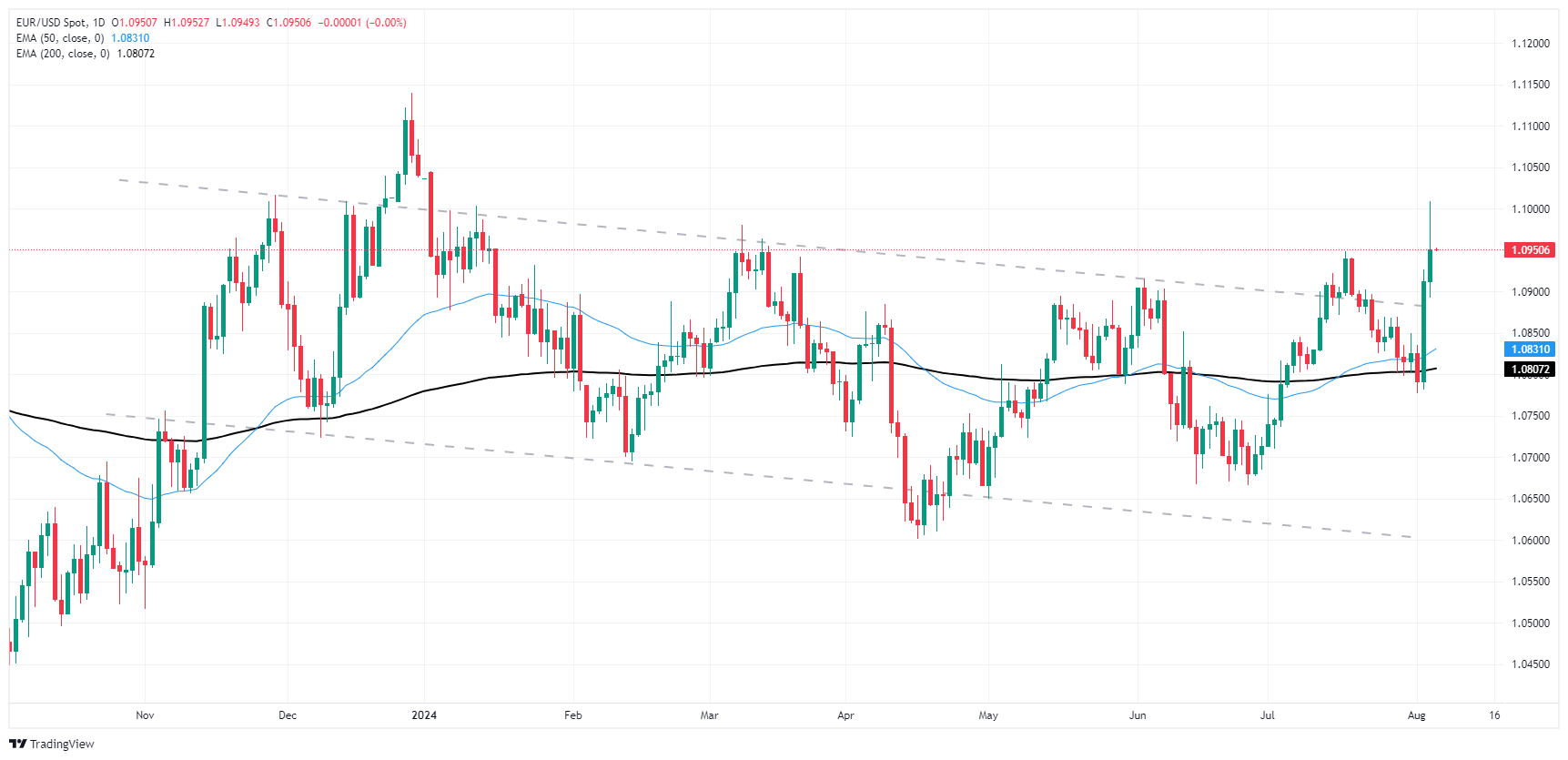EUR/USD jumps but fails to grasp 1.10
- EUR/USD bumped higher on Monday before easing back into range.
- European Retail Sales due on Tuesday, economic calendar remains thin.
- Softening US data keeps rate cut hopes pinned to the ceiling.
EUR/USD scrambled for higher ground on Monday, launching bids into 1.1000 before settling back into a familiar range near 1.0950 and failing to set a fresh high for 2024. Broad-market expectations for rate cuts from the Federal Reserve (Fed) have run well ahead of the curve, with investors hoping for an initial double-cut from the Fed in September.
Forex Today: Fed’s rate cut gathers pace
The economic calendar remains thin overall for the trading week, though European Retail Sales will be one last speedbump for the Fiber before markets can fully settle in for the long wait to September’s rate call season. Pan-EU Retail Sales are expected to ease to just 0.1% for the year ended in June compared to May’s YoY period of 0.3%.
Based on the CME’s FedWatch Tool, the rate markets are currently indicating an 85% probability of a 50 basis points double-cut from the Fed on September 18th. This change in sentiment follows mixed US data on Friday and Monday. The economic data calendar for the rest of the trading week is relatively light, which gives the markets some breathing space and time to analyze their current positions.
The US Composite Purchasing Managers Index (PMI) for July came in at 54.3, below the expected 55.0. On the other hand, the ISM Services PMI for the same period increased to 51.4, surpassing the expected 51.0 and returning to expansion territory above 50.0. Despite this, the ISM Services Prices Paid for July rose to 57.0 from 56.3, exceeding the market's anticipated decrease to 55.8. This indicates that inflation pressures at the business level are still present.
EUR/USD technical outlook
Fiber has once again broken out of the top end of a rough descending channel on daily candlesticks, but a lack of determined bullish momentum will likely leave bids to get swamped back into the 200-day Exponential Moving Average (EMA) at 1.0801.
Despite thin, overextended gains on the daily chart, price action has chalked in a rising pattern of higher lows, and bullish hopefuls will be looking to kick EUR/USD into a fresh bullish cycle after the pair spent most of 2024 churning in the midrange.
EUR/USD daily chart
Euro FAQs
The Euro is the currency for the 20 European Union countries that belong to the Eurozone. It is the second most heavily traded currency in the world behind the US Dollar. In 2022, it accounted for 31% of all foreign exchange transactions, with an average daily turnover of over $2.2 trillion a day. EUR/USD is the most heavily traded currency pair in the world, accounting for an estimated 30% off all transactions, followed by EUR/JPY (4%), EUR/GBP (3%) and EUR/AUD (2%).
The European Central Bank (ECB) in Frankfurt, Germany, is the reserve bank for the Eurozone. The ECB sets interest rates and manages monetary policy. The ECB’s primary mandate is to maintain price stability, which means either controlling inflation or stimulating growth. Its primary tool is the raising or lowering of interest rates. Relatively high interest rates – or the expectation of higher rates – will usually benefit the Euro and vice versa. The ECB Governing Council makes monetary policy decisions at meetings held eight times a year. Decisions are made by heads of the Eurozone national banks and six permanent members, including the President of the ECB, Christine Lagarde.
Eurozone inflation data, measured by the Harmonized Index of Consumer Prices (HICP), is an important econometric for the Euro. If inflation rises more than expected, especially if above the ECB’s 2% target, it obliges the ECB to raise interest rates to bring it back under control. Relatively high interest rates compared to its counterparts will usually benefit the Euro, as it makes the region more attractive as a place for global investors to park their money.
Data releases gauge the health of the economy and can impact on the Euro. Indicators such as GDP, Manufacturing and Services PMIs, employment, and consumer sentiment surveys can all influence the direction of the single currency. A strong economy is good for the Euro. Not only does it attract more foreign investment but it may encourage the ECB to put up interest rates, which will directly strengthen the Euro. Otherwise, if economic data is weak, the Euro is likely to fall. Economic data for the four largest economies in the euro area (Germany, France, Italy and Spain) are especially significant, as they account for 75% of the Eurozone’s economy.
Another significant data release for the Euro is the Trade Balance. This indicator measures the difference between what a country earns from its exports and what it spends on imports over a given period. If a country produces highly sought after exports then its currency will gain in value purely from the extra demand created from foreign buyers seeking to purchase these goods. Therefore, a positive net Trade Balance strengthens a currency and vice versa for a negative balance.